Featured Comment:
“Delicious and super fast / easy if you have the ingredients on hand.”
– Hester (from Pinterest)
What is Kabocha no Nimono?
“Kabocha no Nimono” (かぼちゃの煮物) is a simmered dish made with bitesize pieces of kabocha cooked in a dashi-based broth seasoned with Japanese condiments such as soy sauce, sake and mirin. “Nimono” is a popular Japanese home-style cooking method and can be used for a variety of root vegetables, meat and fish.
Kabocha works particularly well for nimono since the soft flesh absorbs all the flavors of the broth, creating a delightfully soft and flavorful side dish. The skin is often left on, which adds to its visual appeal with its deep green appearance. The skin is packed with nutrients and stops the kabocha from falling apart during and after cooking.
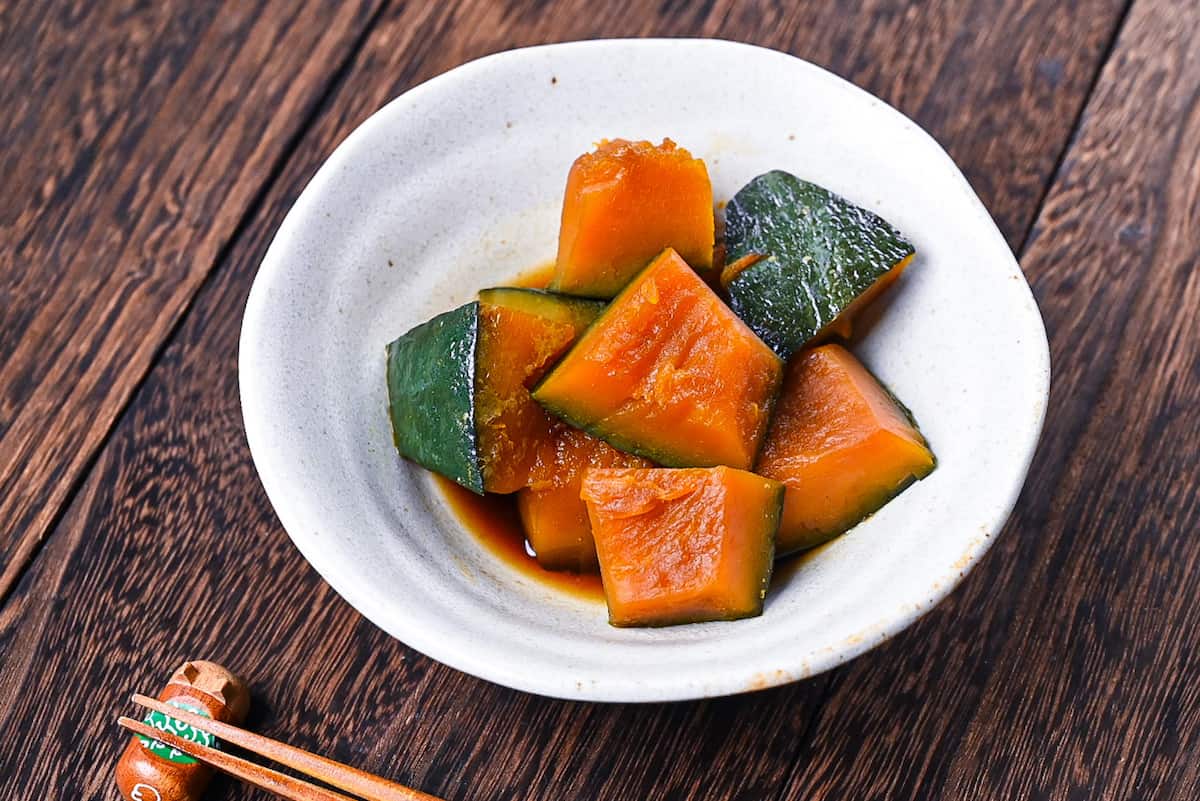

How I Developed This Recipe
Kabocha no Nimono is a classic, comforting dish that’s a staple in Japanese home cooking. When I was putting this recipe together, I wanted to stay true to its roots and capture the essence of what makes this dish a beloved staple in many Japanese households.
The idea was to bring out the warmth and gentle sweetness of the pumpkin, creating a dish that’s both comforting and subtly flavorful.
It’s a simple yet hearty dish that captures the cozy feel of kabocha no nimono!
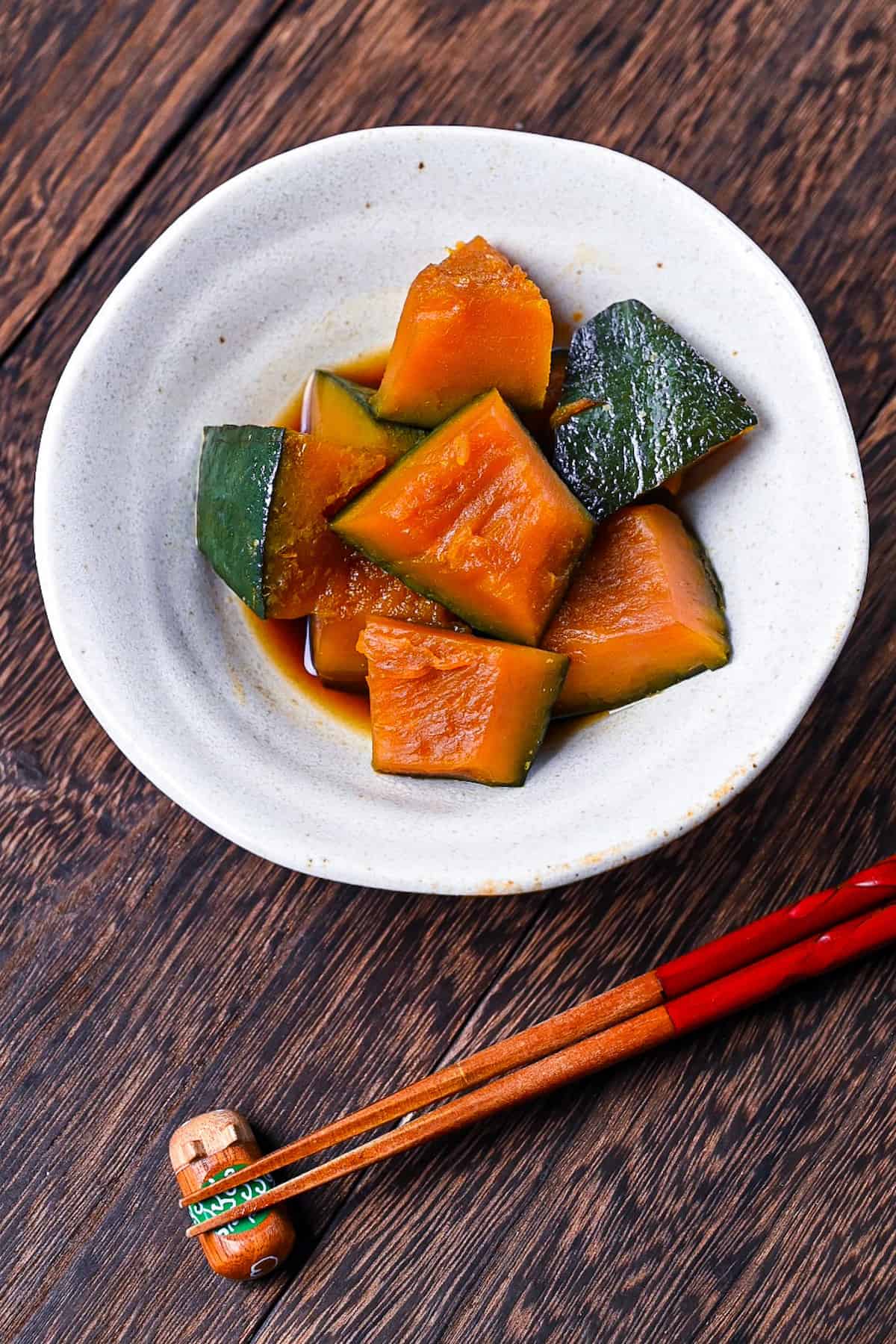
Visual Walkthrough & Tips
Here are my step-by-step instructions for how to make Kabocha no Nimono at home. For ingredient quantities and simplified instructions, scroll down for the Printable Recipe Card below.
Start by cutting the kabocha in half (or quarters, depending on how much you want to make) and scoop out the seeds with a spoon.
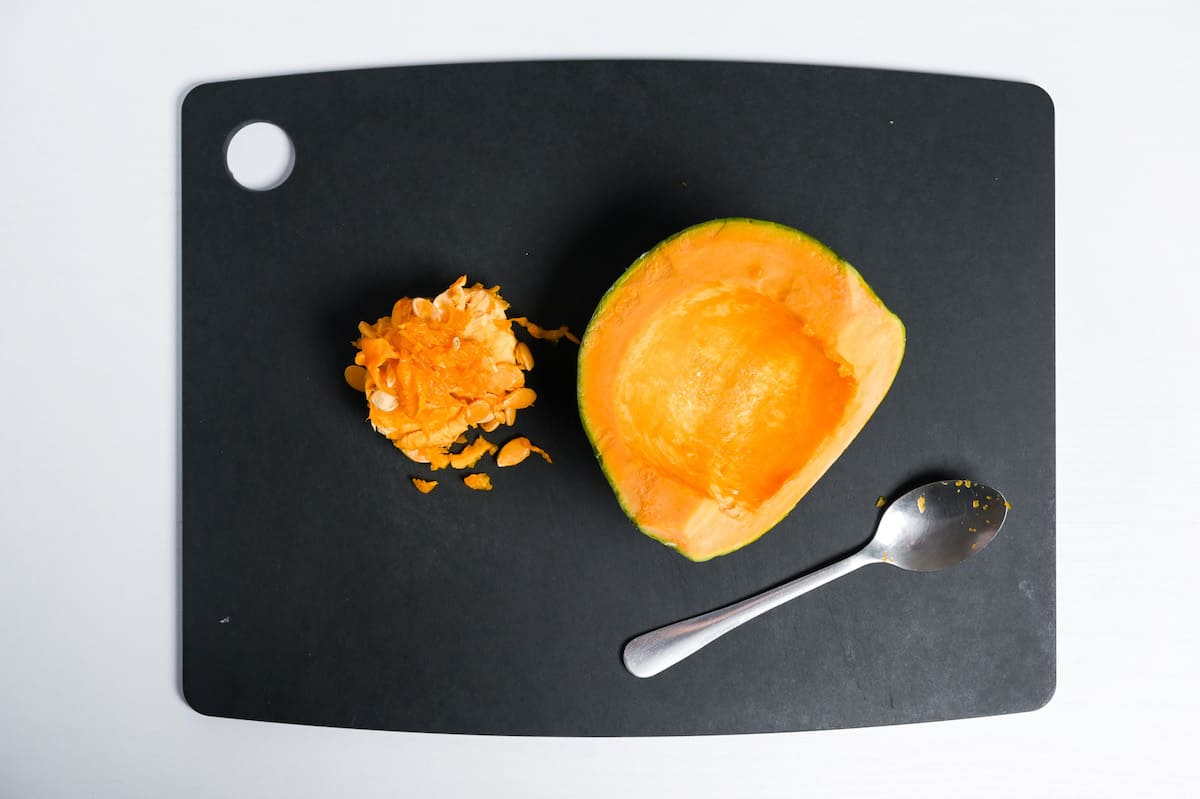
Cut the kabocha into large bitesize pieces, leaving the skin on. Try to keep the sizes uniform to ensure even cooking.
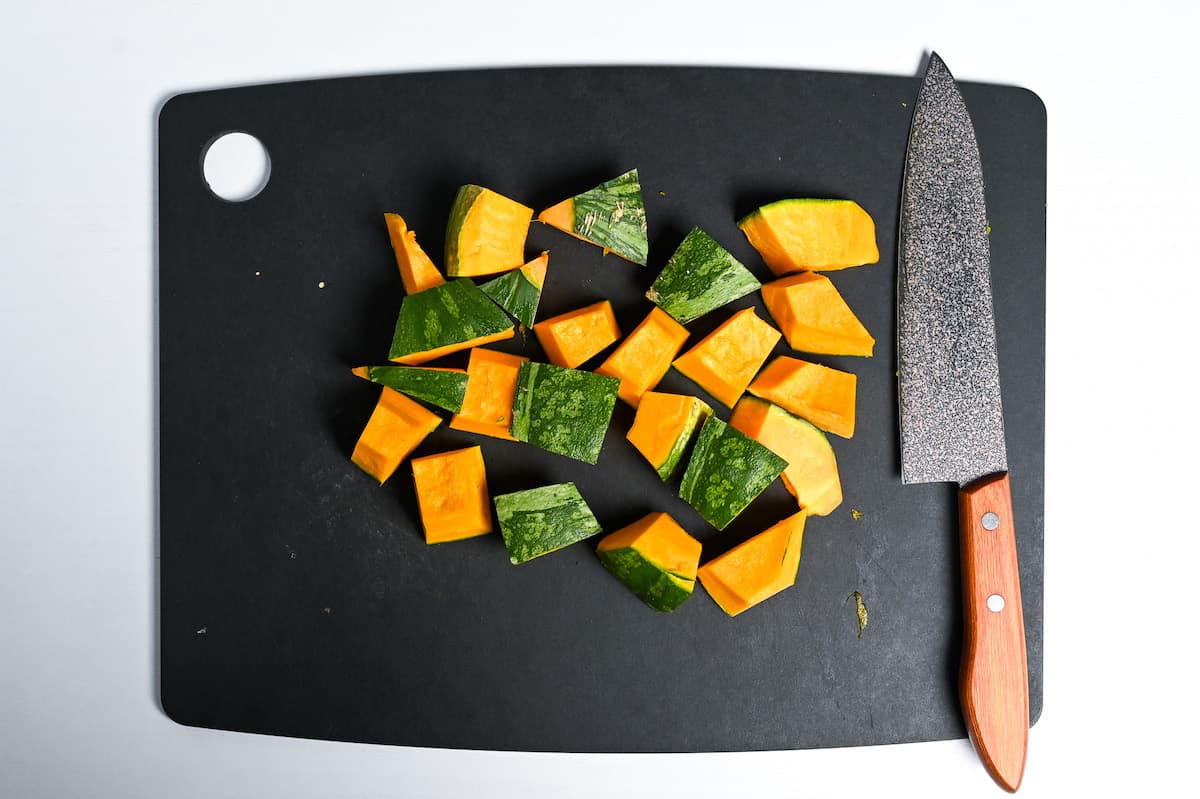
Place the kabocha down flat so it doesn’t roll when you cut it, and be sure to use a sharp knife to cut it smoothly with less force.
Take a large saucepan, wide enough to fit the kabocha in one layer. Place the kabocha pieces at the bottom of the pan with the skin side facing up.
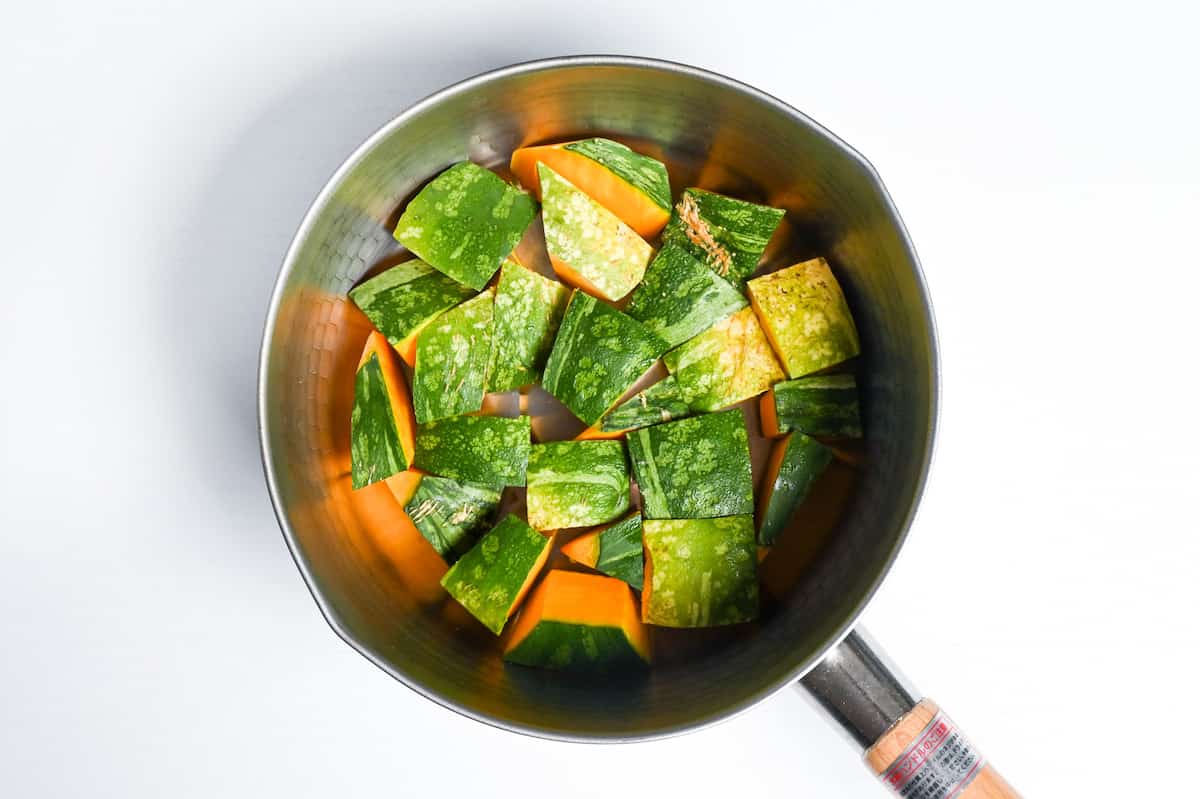
Add your choice of dashi stock to the pot and place it on the stove over medium heat.
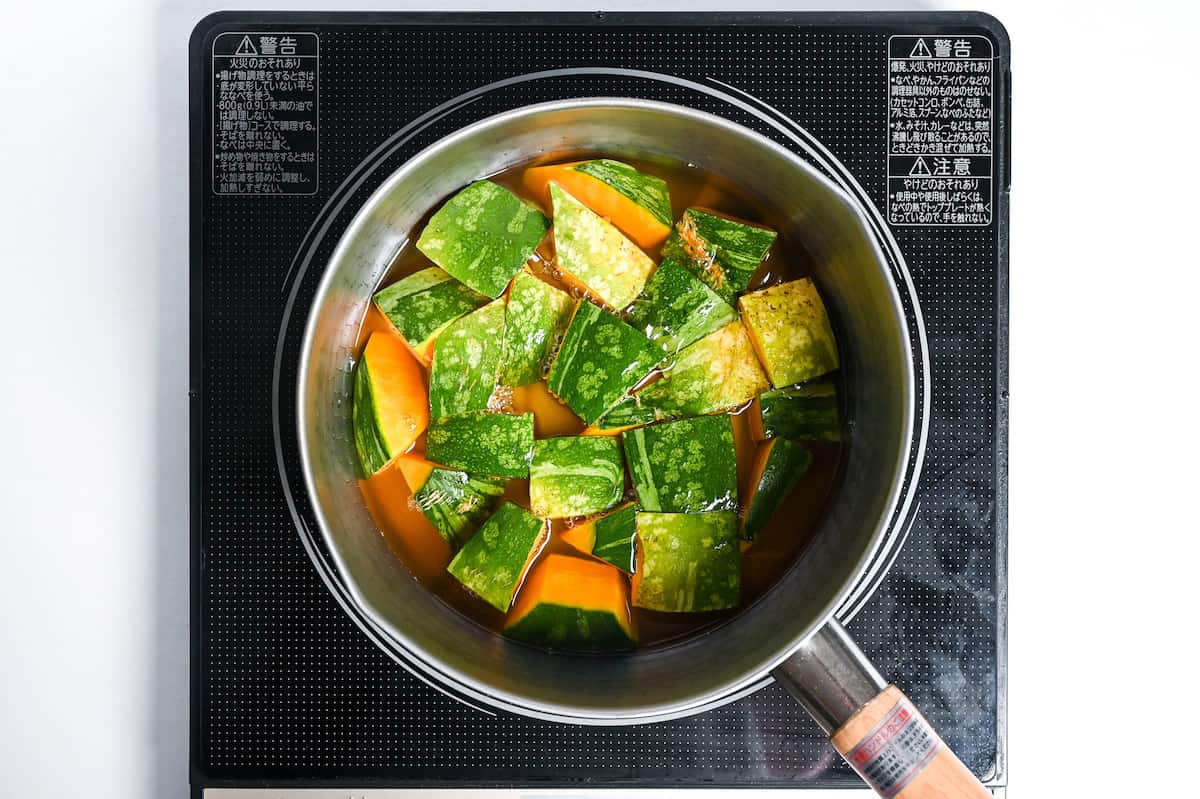
Once the dashi begins to boil, add the sugar, mirin, sake and soy sauce, and allow to boil for 2 minutes.
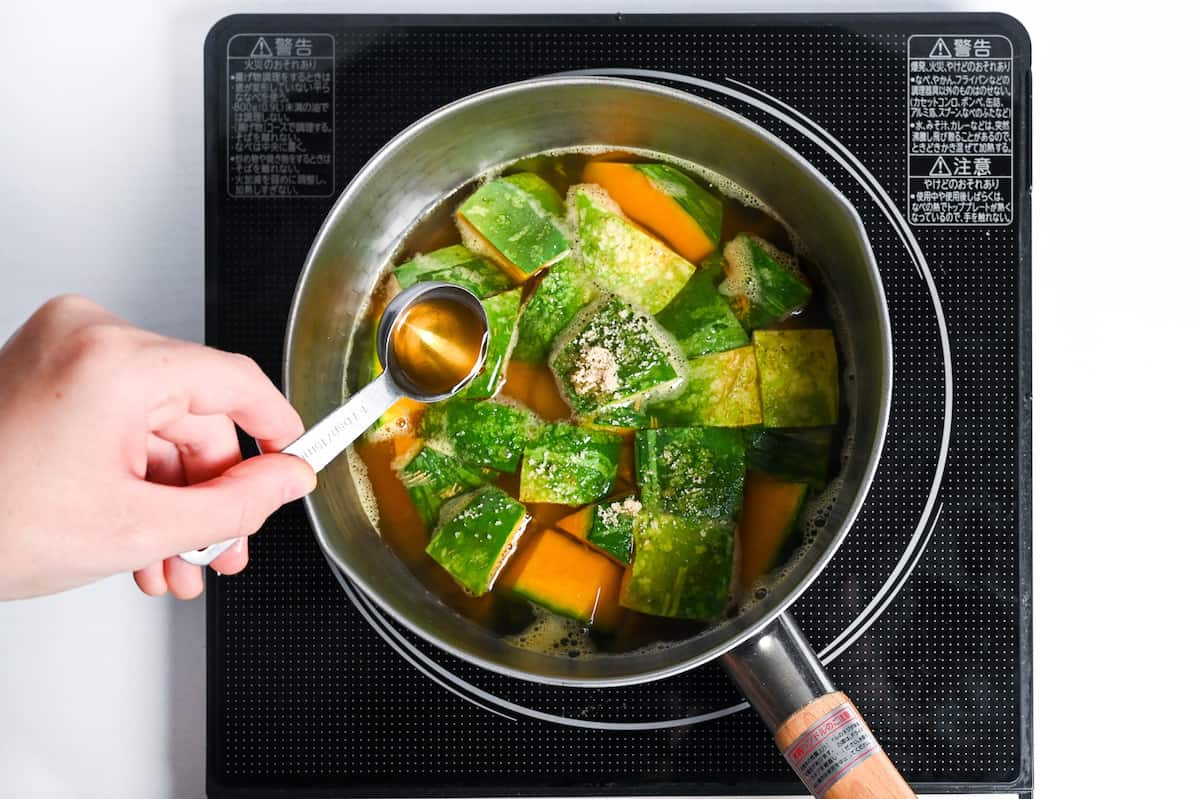
Lower the heat to a simmer and place the drop lid on top so that it is in direct contact with the surface of the kabocha. If you don’t have a drop lid, you can use a piece of foil or baking paper.
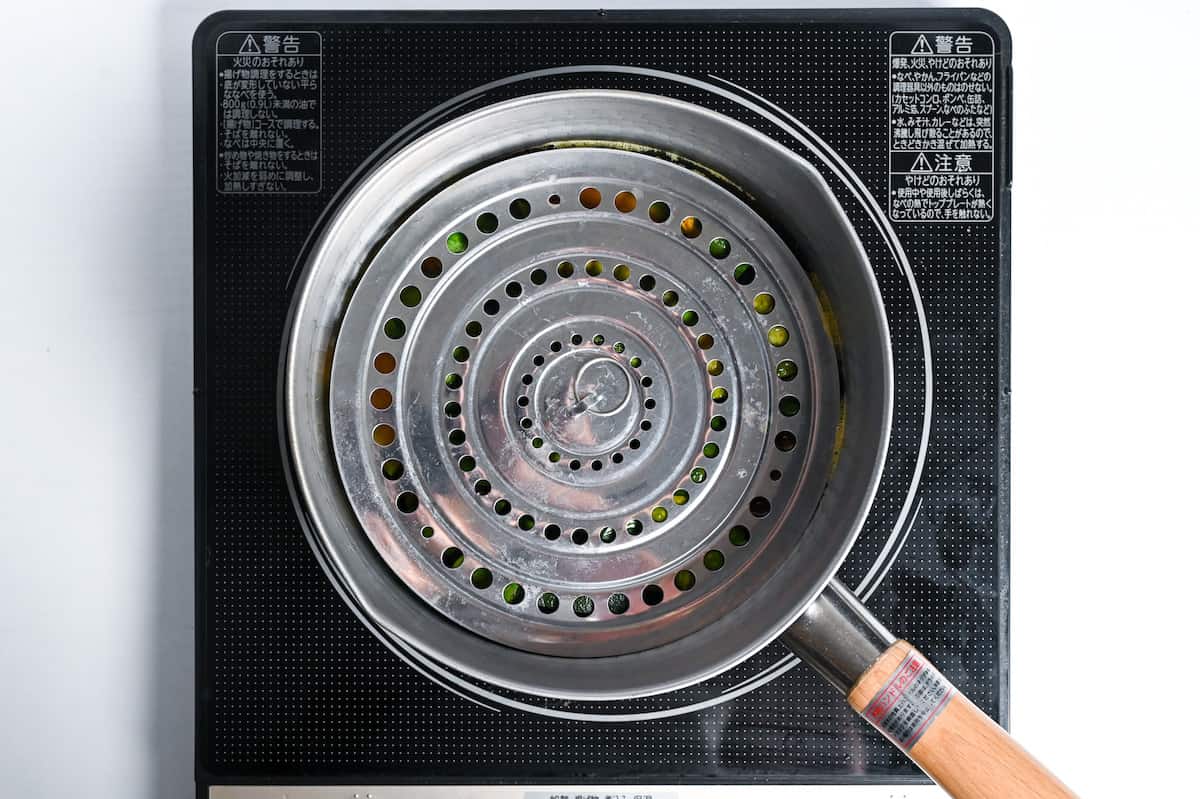
Using a drop lid helps the broth disperse more evenly around the kabocha. It also stops the kabocha pieces from moving around in the broth and breaking. To learn more about how to make a drop lid and why we used them, check out my Otoshibuta post.
Simmer for 10-15 minutes or until you can pierce the kabocha with a fork. Check occasionally and be careful not to overcook.
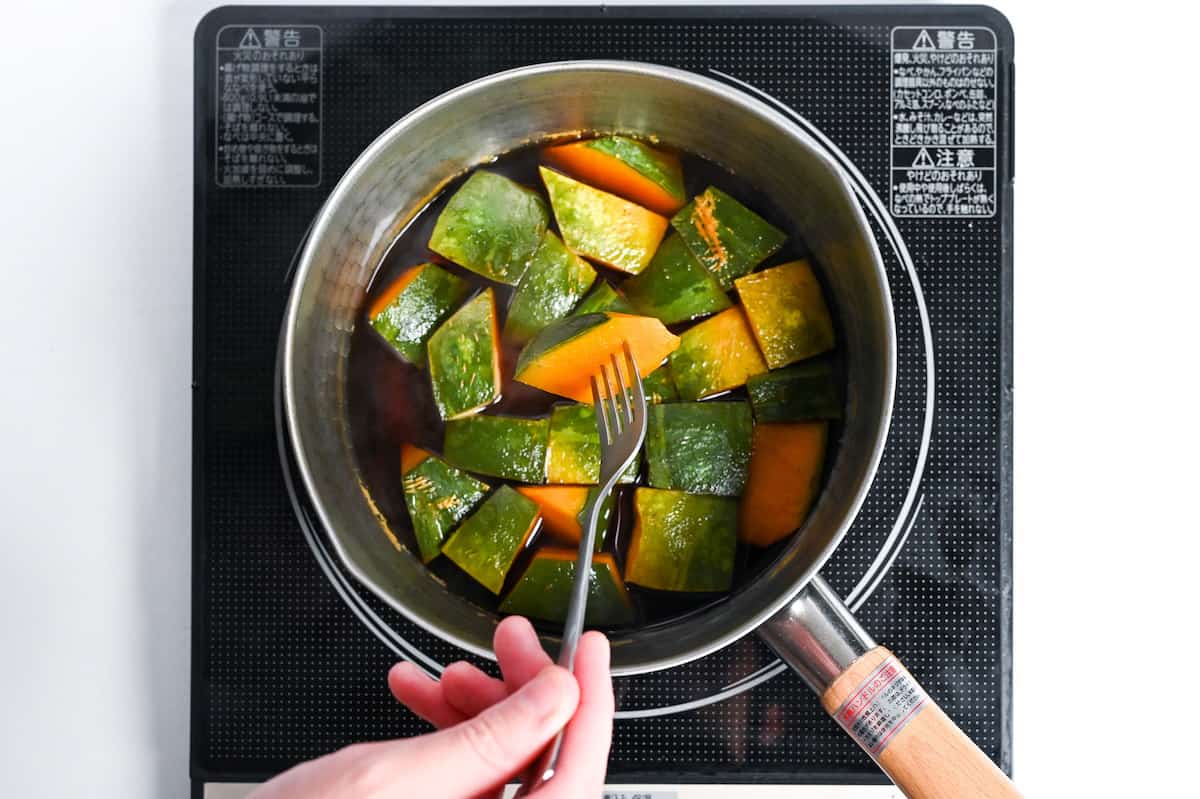
Kabocha nimono can be served either hot or cold. Enjoy as a nutritious side dish, also a great addition for bento boxes!
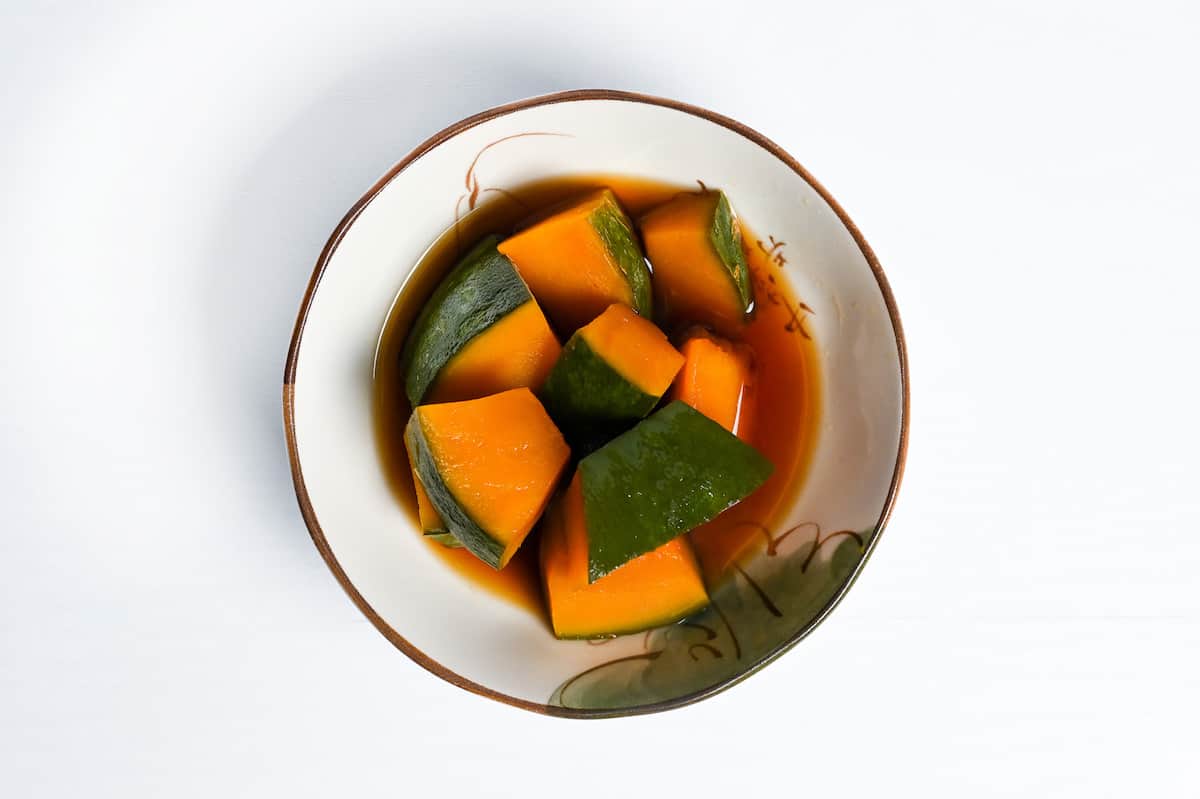
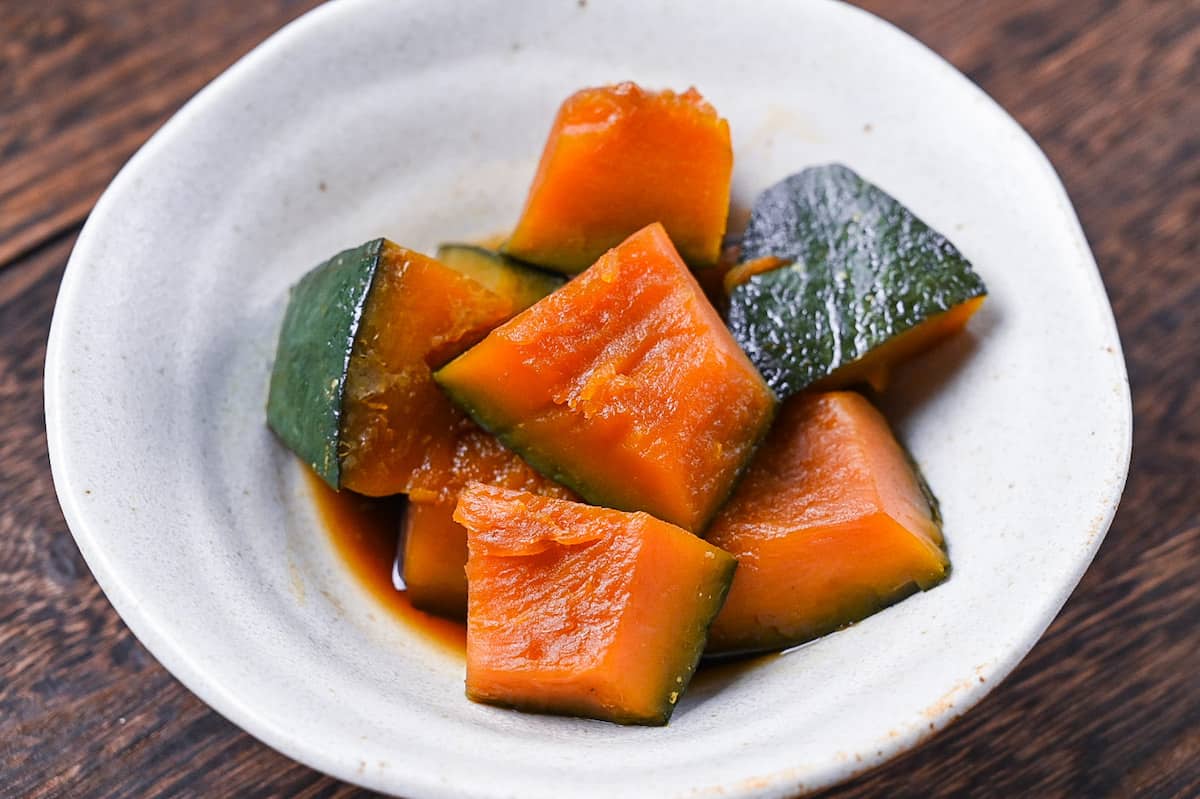
How to Store
Kabocha no Nimono can be stored in an airtight container in the fridge for 3-4 days. Leaving it in the broth will make it deteriorate faster so it is recommended to discard the broth before storing.
You can also freeze it for up to one month. Divide into smaller portions and wrap with plastic wrap, then store in a freezer bag or airtight container to protect it from freezer burn.
Frozen simmered pumpkin can be defrosted in the fridge. If serving in a bento, it is recommended to add it frozen so that it can thaw at room temperature and stay cool until it is time to eat.
Kabocha no nimono can be eaten both hot or cold so there is no need to reheat unless that is your preference. Reheating is not recommended since it can cause the texture to become too soft, but if you prefer it hot, microwaving is the best method.
Storage summary
Room temperature – Not recommended.
Refrigerated – Discard broth and store for 3-4 days in an airtight container.
Frozen – Discard broth and wrap. Freeze for up to 1 month.
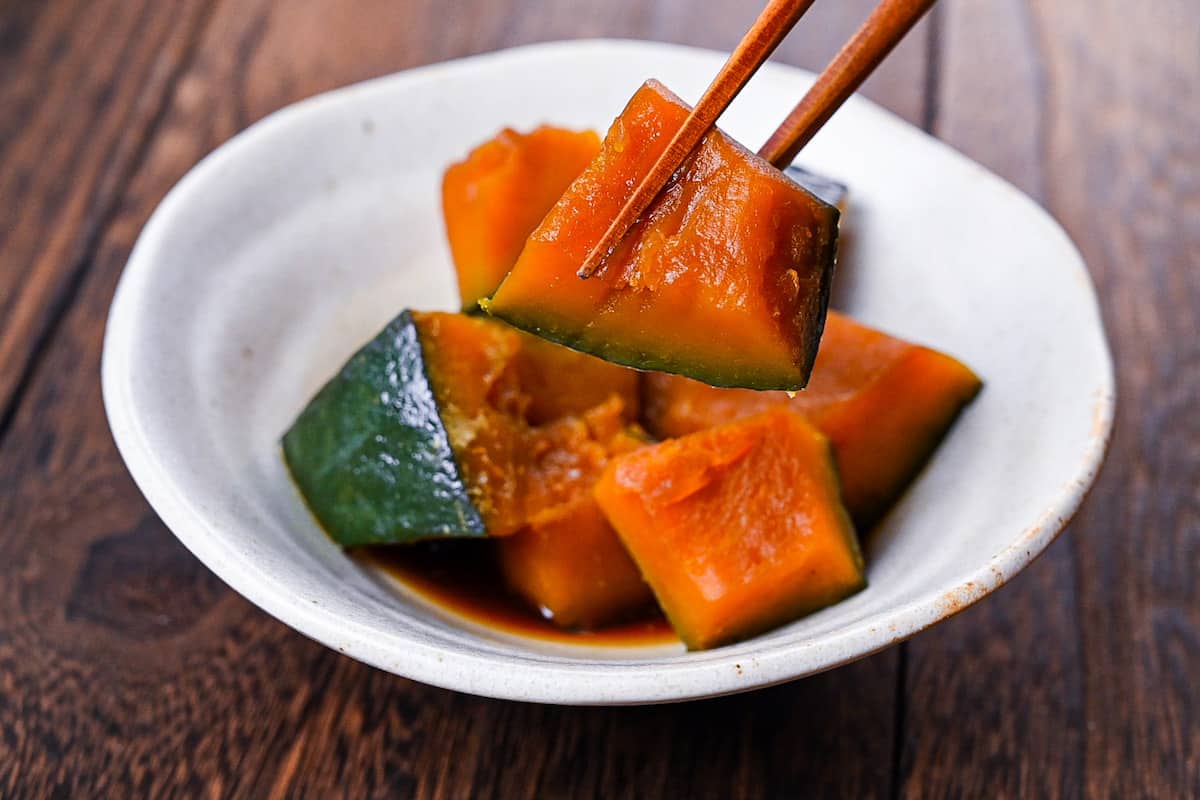
I hope you enjoy this Japanese Simmered Pumpkin recipe! If you try it out, I’d really appreciate it if you could spare a moment to let me know what you thought by giving a review and star rating in the comments below. It’s also helpful to share any adjustments you made to the recipe with our other readers. Thank you!
More Japanese Side Recipes
- Addictive Izakaya Style Salted Cabbage (Yamitsuki Shio Cabbage)
- Hijiki Seaweed Salad (Hijiki no Nimono)
- Chikuzenni (Simmered Chicken and Vegetables)
- Simmered Kiriboshi Daikon Radish
Hungry for more? Explore my side recipe collection to find your next favorite dishes!
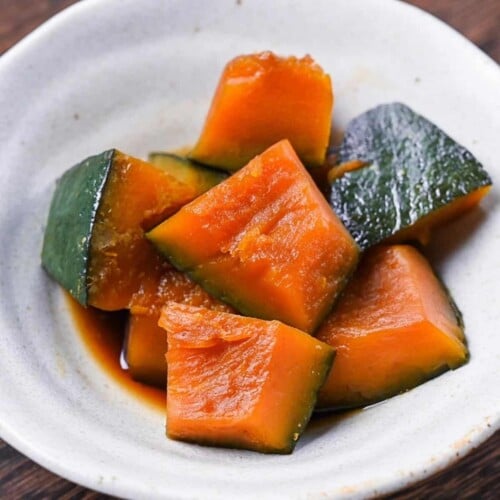
Japanese Simmered Pumpkin (Kabocha no Nimono)
Ingredients
- 450 g kabocha squash skin-on
- 300 ml dashi stock use kombu/shiitake dashi for plant-based diets
- 2 tbsp mirin
- ½ tbsp sugar
- 2 tbsp soy sauce
- 2 tbsp sake
Instructions
- First, scoop the seeds and soft pulp out of 450 g kabocha squash and discard.

- Cut the kabocha into equal size chunks, leaving the skin on.

- Place the kabocha pieces in a large pot with the skin side facing up. Make sure the kabocha pieces make only one layer in the pan so that the pieces aren't overlapping or sitting on top of one another.

- Add 300 ml dashi stock to the pot, place on the stove and bring to a boil over a medium heat.

- Once the dashi is boiling, add ½ tbsp sugar, 2 tbsp mirin, 2 tbsp soy sauce and 2 tbsp sake Continue to boil for 2 minutes and then lower the heat to a simmer.

- Place a drop lid in the pot touching the surface of the kabocha (you can use a sheet of foil or baking paper if you don't own a drop lid) and simmer for 10 mins.

- Pierce with a fork to check the softness. If it's not fully done, continue to simmer with the drop lid and check every 2-3 minutes.

- Enjoy!

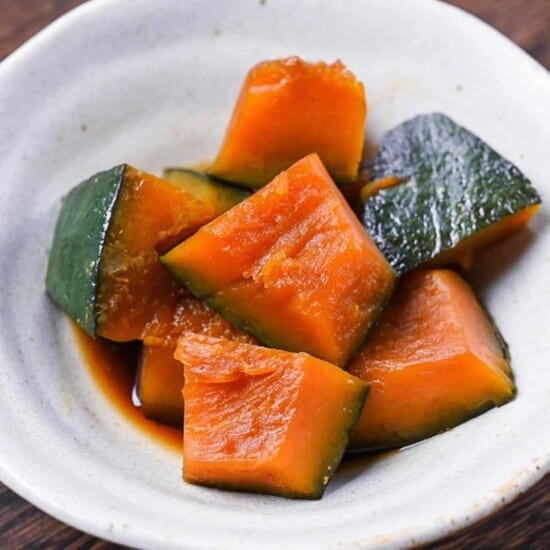


Ahhhh, this sounds amazing.
Aloha! I have a question — why is the dashi added first, and not mixed with the other seasonings before bringing to the first boil?
Hi Erika,
Thank you for your question!
You can add them all at once, but in Japanese cuisine, we tend to add seasonings in layers, especially for simmered dishes. I’ve briefly mentioned the concept in this Japanese condiments post (https://sudachirecipes.com/top-20-japanese-ingredients/) if you’re interested!
Yuto
Hallo Omura-San, I seem to have encountered an issue. Wanted to upscale your recipe (I’ve got a 3kg kabocha on kitchen counter that needs preparing. But when i clicked the ‘3X’ nothing happened…!
Hi Anthony,
Thank you so much for pointing that out! I looked into it and there was some backend error, it should be fixed now. I really appreciate it!
Yuto